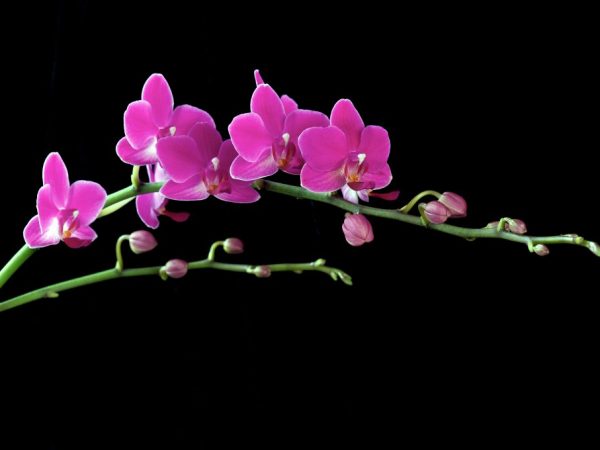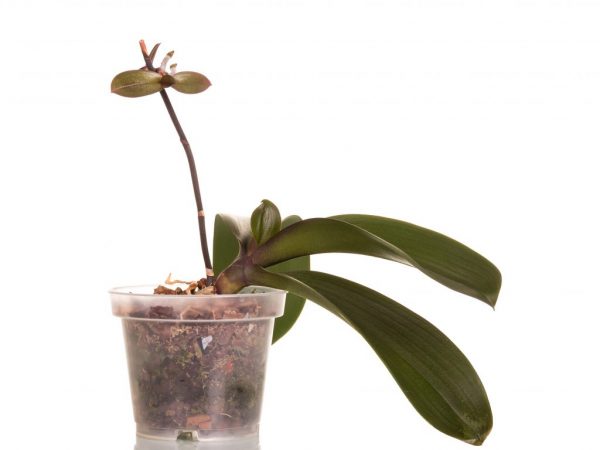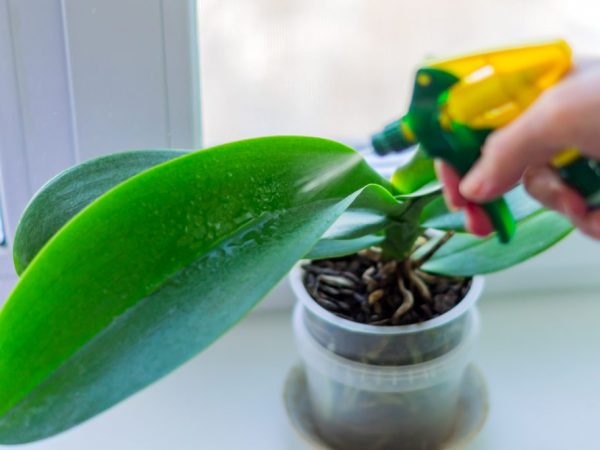Orchid flower stalk
The flowering of indoor plants is of decorative value. A healthy orchid flower stalk is the key to a large number of buds.
- Peduncle characteristic
- Care during the growth of the peduncle
- Peduncle damage
- Root and peduncle
- Orchid stimulation
- Drought method
- Temperature drop
- Reproduction of an orchid using a peduncle
- Stem cuttings
- Growing in water
- Peduncle pruning
- Reasons for the absence of a peduncle
- Humidity level
- Indoor light
- Watering mode
- Temperature
- Pests and diseases
- Conclusion

Orchid flower stalk
Peduncle characteristic
A peduncle is the shoot of a plant on which buds, buds and seeds are formed. The orchid produces one shoot during the flowering period. With the help of the arrow, the flower reproduces.
The size of the shoot is from 10 to 30 cm. When the arrow reaches more than 10 cm, it should be tied up. The arrow must not be long. If the peduncle begins to grow more than 40 cm, the top is cut off by 2-3 mm.
The buds grow in the 2nd month from the beginning of the formation of the arrow.
The peduncle is responsible for flowering. In the process of growing an orchid, it is important to adhere to a number of rules so that the plant will release an arrow.
Care during the growth of the peduncle
During the period of active growth, favorable conditions are created for the plant. Factors affecting growth include:
- Illumination. A little light will affect the development of the shoot.
- Watering. After the arrow begins to climb, the plant is watered as the soil dries up.
- Top dressing. Top dressing will help to increase the number of buds. The orchid is fertilized before the first bud appears. Top dressing after flowering has begun will cause flowers to fall off.
The flower should not be repotted as it can cause stress. If the peduncle has stopped growing, then it is cut off. The cut site should be treated with wood ash.
Peduncle damage
In case of injury to the arrow, the degree of damage is taken into account. If the shoot was damaged superficially, then it is treated with a mixture of ash and activated carbon, after which it should be strengthened with additional fixators.
If the arrow is completely broken off, then the break is trimmed and treated with activated carbon. The shoot that broke off is used for breeding.
Root and peduncle
An orchid may develop an aerial root, which is often confused with an arrowhead. To recognize a shoot, you need to inspect the growth site. The root appears at the base of the leaf. The pedicel forms in the leaf sinus.
However, sometimes the form of growth interferes with determining the shoot. The arrow is able to break the leaf and grow downward. Such cuttings must be removed.
Orchid stimulation
Sometimes, at home, the orchid does not bloom for a long time. The reason for this is the stable growth conditions.
In order for a home orchid to release a flower stalk, the plant is stimulated with stress. Stimulation is carried out in two ways - by the method of drought and temperature drop.
Drought method
Reducing watering causes the orchid to release a flower stalk. In the hot period, the flower is moistened with 1 p. in 4 days, in a cool one - 1 p. in Week.
During this period, foliage is not sprayed.10 days after reducing watering, the leaves of the plant become lethargic and the flower begins to release an arrow. This method will cause the orchid to re-bud after a short break in flowering.
Temperature drop
In its natural environment, the orchid blooms in spring, after cold weather. At home, it is important to create the same temperature.
To do this, the pot must be placed on a loggia or balcony. The temperature drop should be no more than 5 ° C. This method will help achieve flowering from an orchid that has been dormant for a long time.
Reproduction of an orchid using a peduncle

Peduncle propagation is more effective than seeds
The cut arrow of the plant is used to grow a flower at home. This method is considered to be more effective than seed propagation. Breeding an orchid with a peduncle is carried out in two ways.
Stem cuttings
This procedure is carried out in late spring or early summer. Cuttings are cut in this way:
- The lower leaves are cut off.
- Sections are sterilized with activated carbon.
- The plant is fertilized with nitrogen fertilization.
- After the formation of roots on the cuttings, the shoot is cut off.
After cutting, the peduncle must be planted in prepared soil. Within two days, a young orchid should not be watered so that the plant can take root. After 2-3 months, the flower will grow. It is important to ensure that the stalk does not break during cutting.
Growing in water
This method is used if the flower froze, is sick, or the peduncle breaks off before flowering.
The sequence of the procedure:
- The stalk is placed in a bottle, after cutting off the neck by 5 cm.
- The container is filled with water with the addition of activated carbon. The shoot should be 4-5 cm in the water.
- A razor cuts a scale on an arrow to awaken the kidney
- The cut site is treated with cytokinin ointment.
If the shoot is broken, then the place of the break is cut off. The ointment is applied every week for a month. The liquid in the bottle is changed once a week. After 3 weeks, the plant has a developed root system and can be planted in a pot.
Peduncle pruning
After the buds fall off, the old arrow is cut off to put the orchid into a dormant state. The plant is able to shed the peduncle, but the sooner the arrow is removed, the faster the orchid will bloom again. The dead shoot will consume the plant sap, which will prevent the orchid from blooming again.
Pruning is carried out 3-4 days after the end of flowering. There are several rules for the procedure:
- For work, a sharp garden pruner is used, which is disinfected with alcohol.
- After pruning, a short shoot should remain, about 2-3 cm.
- The cut site is dried with cotton wool and treated with activated carbon.
Sometimes the shoot does not stop growing after the flowers fall. After a while, new buds form on such an arrow.
On such a shoot, babies with roots and buds can also form. They are used to grow shoot orchids.
Reasons for the absence of a peduncle
The conditions for keeping an orchid depend on the variety and age of the plant. However, there are general requirements for care, non-observance of which will lead to a deterioration in the vital signs of the flower. It is important to understand why the plant is not able to release the arrow.
Humidity level

The moisture level affects the appearance of the peduncle
Orchids grow in low humidity, but too dry air will prevent the plant from forming a peduncle. Due to a lack of moisture, the buds may crumble without opening. The moisture level depends on the type of orchid:
- Vandas bloom occurs at 70-80% moisture in the air during the day and 60% at night;
- Dendrobiums and Phlenopsis require 30-40% humidity;
- Cattleya produce a peduncle at 40-50% humidity.
Air humidity is lowered when the flower is stimulated by the temperature drop method. Otherwise, the root system will freeze and the plant will die.
Indoor light
Daylight hours for Phalaenopsis and Dendrobium should be at least 8 hours. In winter, the plant requires additional light sources. Special phytolamps are used for illumination. The amount of light required depends on the type of plant:
- Cymbidium produces a peduncle at 12 hours of light;
- Paphiopedilum requires 14 hours of light;
- Catleys grow with a daylight hours of 12 hours.
Lack of lighting affects not only the ability of the plant to form a shoot. Without the right amount of light, an arrow will appear, but the plant will not bloom.
Watering mode
The arrow appears after stimulating the plant with the drought method. But, being without water for a long time, the flower will die. Moisture-free orchids shed the frog, conserving water in foliage and roots. Watering phalaenopsis and dendrobium is carried out by spraying 1 p. in Week. One spraying every 10 days is enough for sympodial varieties. These include:
- Maxillaria;
- Ludisia;
- Wanda.
Temperature
Temperature is one of the main factors affecting the appearance of an arrow. The temperature drop method is the main way to stimulate the orchid. However, at low temperatures, the flower sheds its peduncle. The level of heat depends on the variety:
- Phalaenopsis will not form an arrow if the room is below 16 ° C;
- Dendrobium dies at temperatures below 14 ° C;
- Cattleya and Wanda can withstand drops of up to 10 ° C, but indoors should be above 12 ° C.
Pests and diseases
A diseased plant is unable to form an arrow. Among the main diseases affecting the peduncle are:
- Powdery mildew. As a treatment, the drug Skor or a solution of colloidal sulfur is used.
- Gray rot. A fungicide will help in the fight against it.
- Anthracnose. The disease is treated with the drugs Ritomil and Mikasan.
Pests can also cause the arrow to be missing. Common harmful insects are:
- Mealybug. The affected plant is treated with soapy water.
- Shield. For treatment, Actellik solution is used.
- Thrips. These insects are destroyed with Fitoverm.
Conclusion
Orchid flower stalk is the basis for buds. He is also involved in the cultivation of these plants. A full-fledged orchid is grown from the shoot that has come off.


